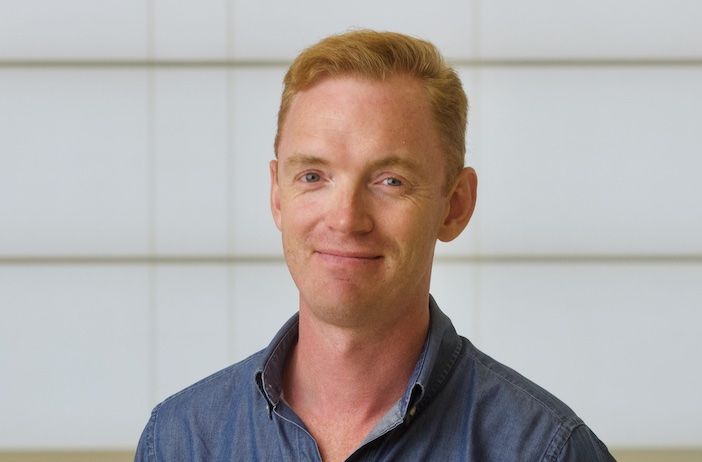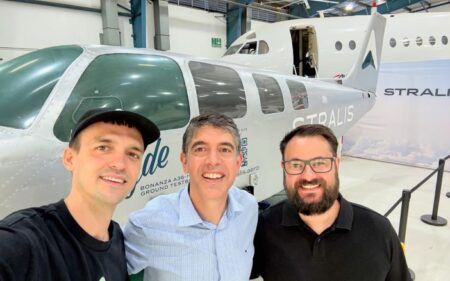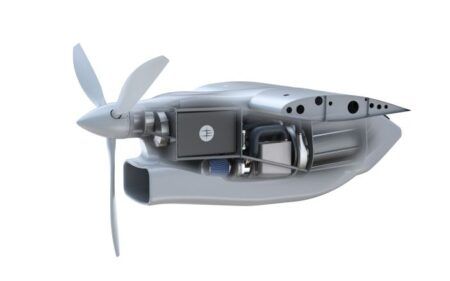Anders Forslund founded Heart Aerospace in 2018 in Gothenberg, Sweden with the goal of developing an all-electric regional aircraft.
The company’s planned 19-seater ES-19 will have a range of 400km (250 miles) and will be able to operate from runways just 750m (2,461ft) long. With a targeted certification by summer 2026, Heart is rapidly growing its team, onboarding experience in its team and developing its design while progressing steadily through testing and certification. The company recently demonstrated the powertrain for the ES-19, the focus of its engineering efforts for the past two years.
In this podcast Forslund details Heart’s approach to development, testing and certification of the ES-19, discusses the importance of knowing your market and why reducing aviation’s environmental impact should still be the top of everyone’s agenda.
Below is the transcript of the interview
Q: What is your background and what led to the founding of Heart Aerospace?
A: I did a PhD in aerospace product development, during which I participated in a research exchange at MIT. I was there during the drone ‘boom’ – you’d get people like Elon Musk turning up and talking about electric aircraft there.
At the time I became sure of two things: one was that there was a lot of opportunity for electrification in aerospace and secondly, that there wasn’t much chance of it happening in Sweden. I thought I would probably have to move to California if I wanted to be involved.
A few years later Norway became the first country in the world to say that they wanted all short haul flights to be all-electric by 2040. That changed my perspective. Sweden has a proud history in aerospace and electric mobility, so we felt it was the right time to start Heart, first as a government research project then as a company.
The next step was applying to Y Combinator to raise funds in Silicon Valley, after which we started recruiting. We’ve grown from two people to a team of 12 and have some really highly experienced people working with us. Our chief technical officer Nigel Pippard is the former CTO of Saab Avionics and was the head of electrical system and avionics for Honda Jet, for example.
Q: What stage of development and testing are you at for the ES-19?
A: Our philosophy is to not to reinvent the wheel. We want to build an aircraft for our market. Today in Norway they are flying 30-year old Dash-8s on short routes everyday. A lot are coming to their end of their lives and need replacing. If we can replace them with electric aircraft it would be great.
So, we are building an aluminum framed, high-winged aircraft with four nacelles. Each of the nacelles contains an electric motor, batteries and power electronics and is a completely self-isolated unit, which is good for safety and redundancy.
So far we have built a prototype of the powertrain – a 400kW, 2300Nm electric motor, plus the battery pack and the power electronics, the motor controller. We’ve put that in the nacelle and built a test rig that resembles the nacelle on the wing and we are testing that now.
We are ready to do five years of design iterations and testing. For the rest of the airframe we are talking to suppliers, Tier Ones and airframe manufacturers.
Q: A self-contained power unit is a different approach than most other electric-aircraft developers – how are you dealing with cooling?
A: If you are building a conventional all-electric aircraft, which takes off and lands using a runway, you need a lot of batteries on board. We are putting in the equivalent of 720kWh. An important thing to know about batteries is that their internal resistance is proportional to the square of the current.
That means if you double the amount of batteries, you reduce the heat generated by them by a factor of four. Our high-battery mass means we are not seeing that much heating during take-offs. We are looking at air-cooling and liquid-cooling. It’s not a huge deal.
Another consideration is that we need to preserve cycle life for the economics of the aircraft to work. A good cell with low internal resistance, even if it isn’t the most energy efficient, will do the job and at a pack level provide enough energy density.
Q: Do you believe battery technology is advanced enough for electric flight?
A: Batteries are getting better all the time. But we have to build this aircraft with the technology that we have available to us today. Two years from now we will have to decide and go with the technology that we want to certify.
But you shouldn’t be building a battery-based aircraft to be as good as a fossil-fueled one. We are not trying to compete in that category. We can develop aircraft that produce less noise and are lower cost. We need to be competitive by starting with the short-range flights and proving our superior economics.
Q: Has marketing been an important part of planning?
A: Yes. You need to focus on the market and where your aircraft will fit in. There is a lot of hype around electric aircraft, eVTOLs (electric vertical take off and landing) aircraft and autonomy. But certifying an aircraft is a lot more difficult than building a prototype. It’s also a lot more difficult to sell an aircraft than develop a prototype.
We know there is a large enough market for a 19-seater aircraft. The technology is mature enough and the economics work. This isn’t the final destination for electric aviation, but it’s the first step and it’s an important one.
Q: Can you tell me about Heart’s approach to certification?
A: We had our first DOA (design organization approval) meeting with EASA (European Aviation Safety Agency) last year, we had the pre-TC (test and certification) meeting.
We’re familiar with the road ahead and EASA are very involved. We are in the conceptual stage and are doing rapid design iterations. Our focus has been on the powertrain. We know it is of a sufficiently high quality, but we have to go through the certification phase to show this. This is especially important with the software – we’ve written it all ourselves and that has to be certified.
From a design point-of-view we have been very aggressive about doing things inhouse – the development of the battery pack, the battery management systems, motor controllers, designing the motor. We want to learn the failure modes and the big challenges, not just get black boxes from suppliers. We want to keep the core IP and core software inhouse, but we will collaborate with suppliers to get it through certification.
Q: What is most challenging about developing and testing an electric aircraft?
A: We are constantly looking for red flags and aren’t seeing any right now, but there probably will be an unknown unknown that will delay us at some point. As a startup, financing the entire test flight program is expensive. It’s a big challenge to finance that before we start getting any revenue.
Q: Do you feel you have enough experience in the team?
A: We have a very experienced team, amongst us we have worked on 67 different aircraft programs. Our CTO has walked this path many times before. We have also received funding and support for DOA and the certification pathway for the aircraft from UK-based firm Baines Simmons, which shows the credibility of our design. But I’m approaching the process humbly. Certifying the aircraft is 100% our focus.
Q: Do you think the aviation sector is ambitious enough about sustainability?
A: That’s a loaded question! We’re seeing a lot of good things. I applaud Airbus on its recent ZEROe hydrogen project for example – it’s a smart idea for transatlantic flight. But I think we should never be content with what we do. We can always do better.
Before Heart, when I was doing my PhD and working for large companies…sometimes it felt like sustainability was restricted to exploratory research. What’s good about being a startup is that we have a concrete, ambitious goal – certification of the aircraft by the summer of 2026. It’s OK if we don’t reach that goal, but it’s not OK to not have a goal. The industry should have concrete goals and be held accountable to them. That last part is really important.
Having said that, there is a lot to be positive about. Heart has received support from the Swedish Government, other Nordic governments, the
UK Government and now the European Commission. Everyone’s heart is in the right place, we just need to deliver now!





